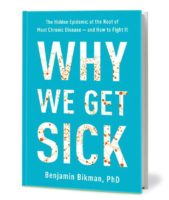The following article is an excerpt from Why We Get Sick by Levels advisor Ben Bikman, printed here with permission. Why We Get Sick is a ground-breaking book on insulin resistance, one of the most prevalent undiagnosed conditions in the world. The book connects the dots between insulin and several major illnesses and offers practical advice for turning around the epidemic of insulin resistance. Here, Bikman offers the historical context for why we talk about glucose, but not enough about insulin.
 Insulin is almost always considered in the context of glucose, which isn’t entirely fair considering the hundreds (thousands?) of things insulin does throughout the body. Nevertheless, in a healthy body, if blood glucose is normal, insulin is usually normal. However, with insulin resistance, insulin levels are higher than expected relative to glucose. In the “story” of insulin resistance and diabetes, we’ve been treating glucose as the main character, but it’s really the sidekick. That is, glucose is the typical blood marker we use to diagnose and monitor diabetes, but we should really be paying attention to insulin levels first.
Insulin is almost always considered in the context of glucose, which isn’t entirely fair considering the hundreds (thousands?) of things insulin does throughout the body. Nevertheless, in a healthy body, if blood glucose is normal, insulin is usually normal. However, with insulin resistance, insulin levels are higher than expected relative to glucose. In the “story” of insulin resistance and diabetes, we’ve been treating glucose as the main character, but it’s really the sidekick. That is, glucose is the typical blood marker we use to diagnose and monitor diabetes, but we should really be paying attention to insulin levels first.
So why the backward priority? Well, we can likely blame the glucose-centric paradigm of insulin resistance and Type 2 diabetes on history and science.
Historically, because it is a cause of Type 2 diabetes, insulin resistance has been lumped into the diabetes mellitus family of diseases.
The first recorded evidence of this family comes from ancient Egypt over 3,000 years ago, through a medical papyrus noting that people with a particular condition experienced “too great emptying of the urine.” Some time after, physicians in India observed that certain individuals produced urine that attracted insects like honey. (In fact, that symptom would inspire part of the name for the disease: “mellitus” is Latin for honey-sweet.)”
Hundreds of years later, in Greece, the excessive urine associated with the disease elicited the name diabete, which means “to pass through,” further emphasizing the remarkable amount of urine patients were producing. All of these observations also came with one common finding: in each case, the excessive urine production was accompanied by weight loss. In fact, though it seems amusing now, early theories were that the flesh was melting into urine.
“Someone can have insulin resistance and still enjoy perfectly normal blood glucose levels. But which value won’t be normal in insulin resistance? Insulin.”
These early physicians, and those that came later, were describing Type 1 diabetes mellitus. It wasn’t until the fifth century that Indian physicians noted two distinct types of this disease, one associated with a young age and losing weight (which modern physicians would come to call Type 1), the other with older age and excess body weight (Type 2). Nonetheless, both were identified by the excess amount of glucose-loaded urine. In the absence of savvier techniques, this understandably led to the disease being defined by glucose, which was causing the common, main observable symptom (polyuria—the technical term for producing too much pee).
However, in doing so, we ignored the other, more relevant half of the problem—insulin. And while diabetes Types 1 and 2 share the symptom of excess glucose, they diverge completely when it comes to insulin. Whereas type 1 diabetes is caused by having too little insulin (or none), Type 2 is caused by having too much.
This “too much insulin” is insulin resistance, and because of its association with Type 2 diabetes, it became wrapped up in the glucose-centric perspective as well.

What causes insulin resistance?
Insulin resistance is a shockingly common condition spurred on by diet and lifestyle. Here are the processes in your body that lead to this dangerous state.
Read the ArticleEarly physicians didn’t have access to modern technology and screening techniques, so it’s understandable that they focused on what they could observe. But why keep focusing on glucose into the modern day?
Well, scientifically, glucose is still more easily measured than insulin. To measure glucose, we only need a simple enzyme on a stick or a basic glucometer, and that technology has existed for roughly 100 years. Insulin, on the other hand, because of its molecular structure and characteristics, is much more difficult to measure. We didn’t have a test until the late 1950s, and it required handling radioactive material. (This discovery was so revolutionary that Dr. Rosalyn Yalow received the Nobel Prize for it!) It’s simpler today, but still not so easy and not very cheap.
So, even though we can now measure insulin, this advance came about too late—we’d already committed to thinking of diabetes as being a “glucose disease” and, in turn, developed clinical diagnostic values for the disease based entirely on glucose. If you run a quick internet search for “glucose+diabetes,” several top results would immediately inform you of the shared clinical values of blood glucose for diabetes Types 1 and 2. (Indeed, the values are the same—126 mg/dL—which should seem odd considering the diseases are so different. Excess glucose is the only thing diabetes Types 1 and 2 have in common; other than glucose, they are wildly different diseases with very different symptoms and progressions.) Try a similar internet search for insulin, and you’ll find plenty of information on insulin therapy but almost nothing about the clinical values of blood insulin for diabetes. Even as a professional scientist who studies this condition, I have a hard time finding a consensus on insulin values for diabetes.
All of this is interesting, but it still doesn’t explain why so many people with insulin resistance are undiagnosed. After all, if we can identify Type 2 diabetes by glucose levels, why not insulin resistance (which is also called “prediabetes”)? Well, we fail to identify it because insulin resistance isn’t necessarily a hyperglycemic state. In other words, someone can have insulin resistance and still enjoy perfectly normal blood glucose levels. But which value won’t be normal in insulin resistance? You guessed it—insulin. If you’re insulin resistant, you’ll have higher than normal levels of insulin. But of course, the problem is both finding a consensus value for “too much” blood insulin and actually getting your blood insulin measured clinically; it’s not part of the standard tests most doctors order.
This is why we can have a scenario where a person is steadily becoming more and more insulin resistant, but the insulin is still working well enough to keep blood glucose in a normal range. This can develop over years, even decades. But because we more typically look at glucose as the problem, we don’t recognize there’s an issue until the person is so insulin resistant that their insulin, no matter how much they produce, is no longer enough to keep their blood glucose in check. It’s at this point, possibly “years after the problem started, that we finally notice the disease.
Ultimately, it is unfortunate that history and science played out the way they did. My single greatest frustration is also the reason so many people with insulin resistance are undiagnosed—we look at it wrong. Perhaps if insulin had been the easier-to-measure molecule, we wouldn’t have lumped Types 1 and 2 diabetes together, and we might have launched a system to identify the disease much earlier—all because we’d have been looking for the more relevant indicator, insulin. After all this, it’s no surprise that insulin is a much better predictor of Type 2 diabetes than glucose, predicting the problem up to 20 years earlier.(1)
Before moving on, it’s helpful to establish a couple of points.
First, as mentioned, insulin resistance increases the risk of Type 2 diabetes. This is true, but this relationship warrants further clarification. Type 2 diabetes is insulin resistance. That is, type 2 diabetes is insulin resistance that has progressed to the point where the body is unable to keep blood glucose levels below the clinically relevant 126 mg/dL. We’ve known this for almost 100 years; German scientist Wilhelm Falta first proposed the idea in 1931.(2) In other words, any time you hear someone speaking about the evils of diabetes, you can just substitute in “insulin resistance” and it’s immediately more accurate. For example, your neighbor doesn’t have a family history of diabetes; she has a family history of insulin resistance.
Second, insulin resistance is a hyperinsulinemic state. That means a person with insulin resistance has more insulin in the blood than normal. (This particular point will become highly relevant when we discuss the unfortunate effects of being in this state for prolonged periods.)
As a reminder, note that insulin resistance per se won’t kill you; it’s just a reliable vehicle that can rapidly get you there by causing other, life-threatening conditions. This means people are experiencing multiple and seemingly diverse health problems that could be improved by addressing one root cause.
Indeed, insulin resistance has a hand in a startling number of very serious chronic diseases, including problems of the head, heart, blood vessels, reproductive organs, and more. Far more than being a mere inconvenience, when left untreated, this is a serious condition. Most people with insulin resistance will ultimately die from heart disease or other cardiovascular complications; others will develop Alzheimer’s disease, breast or prostate cancers, or any number of other lethal diseases.
Understanding how insulin resistance causes these disorders is essential to appreciating how important insulin is to our health.

What causes insulin resistance?
Insulin resistance is a shockingly common condition spurred on by diet and lifestyle. Here are the processes in your body that lead to this dangerous state.
Read the Article
1.Martin, B.C., et al., Role of glucose and insulin resistance in development of type 2 diabetes mellitus: results of a 25-year follow-up study. Lancet, 1992. 340(8825): p. 925-9; Pories, W.J. and G.L. Dohm, Diabetes: have we got it all wrong? Hyperinsulinism as the culprit: surgery provides the evidence. Diabetes Care, 2012. 35(12): p. 2438-42; Weyer, C., et al., A high fasting plasma insulin concentration predicts type 2 diabetes independent of insulin resistance: evidence for a pathogenic role of relative hyperinsulinemia. Diabetes, 2000. 49(12): p. 2094-101; Kekalainen, P., et al., Hyperinsulinemia cluster predicts the development of type 2 diabetes independently of family history of diabetes. Diabetes Care, 1999. 22(1): p. 86-92; Crofts, C.A.P., K. Brookler, and G. Henderson, Can insulin response patterns predict metabolic disease risk in individuals with normal glucose tolerance? Diabetologia, 2018. 61(5): p. 1233; DiNicolantonio, J.J., et al., Postprandial insulin assay as the earliest biomarker for diagnosing prediabetes, type 2 diabetes and increased cardiovascular risk. Open Heart, 2017. 4(2): p. e000656.
2.Falta, W. and R. Boller [title not available]. Wien Klin Wochenschr, 1949. 61(14): p. 221; Falta, W., Insulärer “und Insulinresistenter Diabetes. Klin Wochenschr, 1931. 10(10): p. 438-443.








